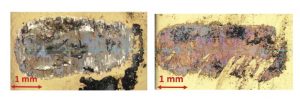 Contact plating material options for electronic connectors: Part 6
Contact plating material options for electronic connectors: Part 6
February 8, 2019 REDWIRE is news you can use from leading suppliers. Powered by FRASERS.
Posted by Harting Canada Inc
The family-owned HARTING Group is a global leader in connectivity solutions. HARTING invented the modular connector and... Read more
Subscribe
Free REDWIRE e-newsletter

Hard-gold-flashed palladium nickel (80/20) contact surface after 300,000 fretting cycles (left), hard-gold contact surface after 900,000 fretting cycles (right)
In this six-part article, the HARTING Technology Group discusses plug-in connectors and options available for contact plating. This final part deals with test arrangement and summarizes the whole. Read Part 1, Part 2, Part 3, Part 4, and Part 5.
Test arrangement
The fretting tests were performed with a tribometer in the HARTING internal laboratory. The test arrangement procedure based on Telcordia GR-1217 – Fretting and Lubrication Tests, which evaluates the risk of fretting for the combination of a specific connector hardware and micro-motion caused by fan vibration or thermal cycling. The distance of the micro motion was set to 48 μm. The applied frequency of the test was 10 Hz. The contact resistance was measured with the LLCR method (Low-Level Contact Resistance, a dry film contact resistance measurement) according to contact resistance test of IEC 60603-2 (1995-09) at the ends, as well as in the middle of the wear track. This LLCR method avoids the reduction of the contact resistance of the contact interface through electrical and thermal breakdown. If the contact resistance of a contact exceeds 20 mOhm, the contact failed the test.
Results
Both sample types fulfill connector specification IEC 60 603-2. Regarding the fretting test, the hard-gold-flashed palladium nickel (80/20) withstands up to 300,000 cycles until the point of failure. After this, the contact surface is worn through and the nickel underlayer, as well as the copper alloy, has started to oxidize, resulting in an increase of the contact resistance. Compared to hard-gold-flashed palladium nickel (80/20), hard gold surface withstands up to 900,000 cycles until the point of failure due to its four-times-thicker noble-metal layer thickness. The contact surface is also worn through, and the nickel started to oxidize, which causes an increase of the contact resistance.
Both contact surfaces show the same wear characteristics. At first, the noble material is worn through. When the nickel is exposed, it starts to oxidize. At the beginning, there is still some noble metal in the wear track, so that the contact resistance is still lower than 20 mOhm. When there are only corrosion products left in the wear track, the contact resistance increases and the contact fails. One of the reasons for the good fretting behaviour of the tested gold layer is the four-times-higher thickness compared to palladium-nickel. Therefore, the time until the hard gold layer is worn through is increased.
Summary
In the area of electronic connectors, hard gold and hard-gold-flashed palladium nickel (80/20) are the most common options used as contact surfaces for connectors in the data range. Both surfaces fulfill the connector specification IEC 60 603-2. Thus, hard-gold-flashed palladium nickel (80/20) is a good and established solution for all applications using the performance levels according to international connector specifications IEC 60 603-2. For much higher demand, especially with more fretting motion cycles, traditionally gold is still preferred. Nevertheless, hard-gold-flashed palladium nickel (80/20) offers the advantage of an enhanced price-performance ratio, and additionally, it is more independent of speculation on the stock market compared to hard gold.
To learn more, contact HARTING.
Share
Posted by Harting Canada Inc
The family-owned HARTING Group is a global leader in connectivity solutions. HARTING invented the modular connector and... Read more